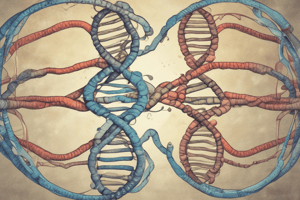Podcast
Questions and Answers
Which technique provides information about structural abnormalities and requires global mosaicism?
Which technique provides information about structural abnormalities and requires global mosaicism?
- Interphase FISH
- Metaphase FISH
- GMA
- G-banded chromosomes (correct)
What is the rate of unbalanced structural rearrangements in newborns per 1000 births?
What is the rate of unbalanced structural rearrangements in newborns per 1000 births?
- 0.16
- 0.97
- 2.04
- 0.63 (correct)
Which type of structural abnormality is less frequently detected in newborns per 1000 births than others listed?
Which type of structural abnormality is less frequently detected in newborns per 1000 births than others listed?
- Deletions, rings (correct)
- Robertsonian Translocations
- Inversions
- Balanced Structural Rearrangements
Which type of FISH does not require global mosaicism but provides structural information?
Which type of FISH does not require global mosaicism but provides structural information?
What is the resolution of GMA in kb?
What is the resolution of GMA in kb?
What is a characteristic of structural chromosome abnormalities?
What is a characteristic of structural chromosome abnormalities?
Which mechanism is responsible for double-stranded breaks that are incorrectly repaired leading to structural chromosome abnormalities?
Which mechanism is responsible for double-stranded breaks that are incorrectly repaired leading to structural chromosome abnormalities?
In structural abnormalities, what does the notation 'del(11)(p11.2p13)' signify?
In structural abnormalities, what does the notation 'del(11)(p11.2p13)' signify?
Which of the following best defines a Robertsonian translocation?
Which of the following best defines a Robertsonian translocation?
The term 'mos' in karyotype nomenclature stands for what condition?
The term 'mos' in karyotype nomenclature stands for what condition?
Flashcards
Chromosome Analysis (G-banding)
Chromosome Analysis (G-banding)
A technique that examines the entire chromosome complement, providing a detailed view of the chromosomes' banding pattern.
FISH (Fluorescence In Situ Hybridization)
FISH (Fluorescence In Situ Hybridization)
A technique that uses fluorescent probes to detect specific DNA sequences on chromosomes.
Metaphase FISH
Metaphase FISH
A type of FISH that detects abnormalities affecting a large portion of a chromosome. It examines the chromosomes during cell division.
Interphase FISH
Interphase FISH
Signup and view all the flashcards
GMA (Genomic Microarray Analysis)
GMA (Genomic Microarray Analysis)
Signup and view all the flashcards
What is a structural chromosome abnormality?
What is a structural chromosome abnormality?
Signup and view all the flashcards
How do non-allelic homologous recombination (NAHR) events occur?
How do non-allelic homologous recombination (NAHR) events occur?
Signup and view all the flashcards
What role does non-homologous end-joining (NHEJ) play in cytogenetics?
What role does non-homologous end-joining (NHEJ) play in cytogenetics?
Signup and view all the flashcards
How do replication errors contribute to structural chromosome abnormalities?
How do replication errors contribute to structural chromosome abnormalities?
Signup and view all the flashcards
What are low-copy repeats (LCRs) and how do they relate to chromosomal rearrangements?
What are low-copy repeats (LCRs) and how do they relate to chromosomal rearrangements?
Signup and view all the flashcards




